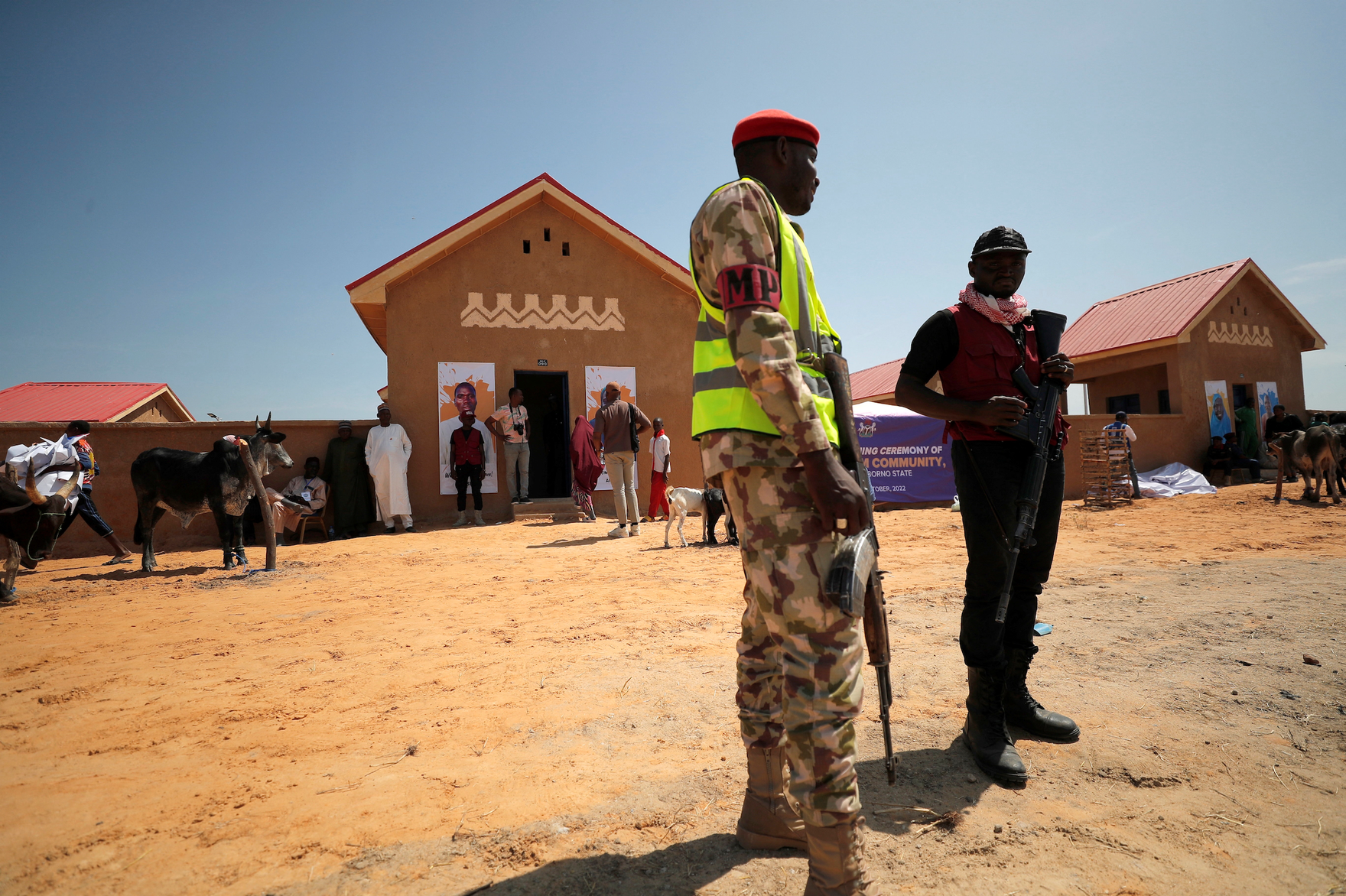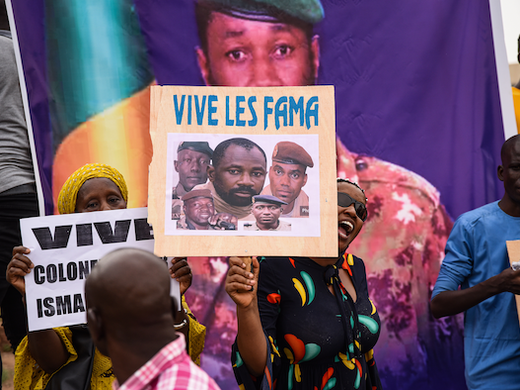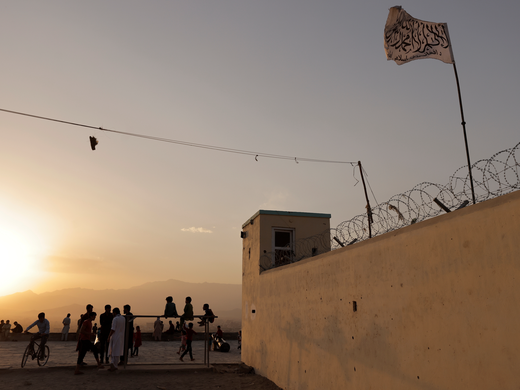In northern Nigeria, groups of terrorists and bandits are increasingly using social media to weaponize disinformation to further their agendas, coordinate activities and recruit new members. In this piece, I outline how some of these armed, non-state actors — including Boko Haram and its offshoots — have leveraged the power of online platforms as part of their broader efforts to achieve their objectives.
JAS (Boko Haram) and Social Media
JAS, or Jama'atu Ahlis Sunna Lidda'awati wal-Jihad, often referred to as Boko Haram, leverages social media for recruitment by sharing videos and messages that glorify jihad and martyrdom. The group uses encrypted messaging apps such as Telegram and WhatsApp for internal communication to aid in coordinating operations and maintaining contact between members. It also disseminates propaganda videos and statements through social media, showcasing its attacks, and messages from leaders and ideological content justifying its actions and promoting its version of Islam.
JAS uses Telegram extensively for its encryption and large file-sharing capabilities, enabling it to distribute propaganda videos and official publications, and to coordinate internally. WhatsApp is also a key platform for the group, facilitating members’ real-time communication and strategic planning.
Additionally, JAS exploits YouTube to upload and share longer propaganda videos, despite continuing efforts to curb such content. Mala Mustapha, a conflict expert, told me in an interview that “JAS’s use of sophisticated propaganda videos is a strategic move to align with their broader objectives, drawing in recruits and financial support from across the globe. Their ability to project strength and operational success through these videos cannot be underestimated.”
The JAS group has also used social media to announce changes in its leadership or organizational status. For instance, when the Islamic State in West Africa Province group broke away from Boko Haram, both factions used social media in an effort to assert their positions and ideologies.
They also disseminate ideological content, such as sermons and religious teachings justifying attacks on civilians and kidnappings, and portray these activities as aligned with their interpretation of Islam. Martyrdom videos glorifying fighters who have died in battle are also shared to inspire recruits by highlighting the perceived spiritual rewards of their actions.
To demonstrate power, JAS releases gruesome videos of executions, including beheadings of captured soldiers and civilians, instilling fear and showcasing its strength vis-à-vis the Nigerian government and its allies. As one local resident who prefers to remain anonymous told me, “the constant stream of videos from JAS creates a sense of fear and uncertainty.”
ISWAP’s Disinformation and Propaganda Objectives
The Islamic State of West Africa Province — known in short as ISWAP — strategically aligns itself with the broader Islamic State narrative and ideology through social media. It shares official IS publications and videos emphasizing its connection to the global network, as part of an effort to show a unified front and to attract sympathizers.
ISWAP uses social media to claim responsibility for attacks, provide operational updates, highlight governance efforts and solicit funds. The multiplicity of uses underscores the importance of social media as a tool in its efforts to communicate, recruit and sustain its operations.
Like JAS, ISWAP utilizes Telegram for its encryption and large file-sharing capabilities, as these features enable it to distribute propaganda videos and official IS publications. “Platforms such as Telegram are the preferred method for sharing messages, statements and videos due to their secure encryption,” notes Saad Abubakar, a cybersecurity security expert.
For wider circulation, YouTube is also an important platform through which ISWAP shares longer propaganda videos, despite the platform’s ongoing efforts to curb such content.
Recent disinformation campaigns have included recruitment videos showcasing military successes and promoting a narrative of invincibility and divine purpose to inspire and indoctrinate potential recruits.
These videos also serve as a fundraising tool, appealing for donations and providing instructions for contributing via cryptocurrencies to ensure anonymity and security. Mustapha notes that the powerful impact of ISWAP’s sophisticated production and dissemination of these propaganda pieces online, much as with JAS’s deployment of these tools, cannot be overstated.
Another expert, Musa Stevens, explained how in “leveraging video content to depict their military prowess and governance, ISWAP not only attracts new recruits but also legitimizes their presence in the region. This dual strategy of fear and perceived stability is key to their influence.”
Additionally, ISWAP employs psychological warfare through gruesome execution videos and footage of attacks to instill fear and demoralize opponents, targeting the general public, local populations and specific groups such as the Nigerian military and vigilantes. The local resident who prefers to remain anonymous told me that ISWAP, like JAS, employed a constant stream of frightening and unsettling videos: “It’s hard to ignore their presence when they show their attacks and executions so openly.”
But fear is not the only impact of their propaganda campaigns. The group’s social media engagement also deploys ideological messaging and justifications for its actions, aiming to solidify its ideological foundation and gain acceptance within certain communities. By highlighting its governance efforts, such as providing food and security in areas under their control, ISWAP seeks to win hearts and minds and establish legitimacy. “These videos reach us even in the camps,” one displaced person told me in an interview. “They use them to ask for money and support, saying we should contribute to their cause even if we can’t fight.”
In short, ISWAP’s propaganda videos are meticulously crafted to serve multiple purposes: recruitment, fundraising and psychological warfare.
Bandit groups continue to leverage Facebook, TikTok and X to disseminate propaganda and showcase their strength.
How Bandits Are Weaponizing Social Media
Bandit groups operating in northern Nigeria have increasingly turned to social media to further their objectives and amplify their presence. These groups, exemplified by figures such as Bello Turji, Captain Maizabo and others, have effectively utilized platforms such as WhatsApp, TikTok, Facebook and X (formerly Twitter) to coordinate activities, disseminate propaganda and communicate with both their members and the broader public.
One of the bandits’ key uses of social media is to aid recruitment and communication. They create closed or secret groups on platforms such as WhatsApp, where they post updates, coordinate attacks and recruit. These groups often use coded language and imagery to avoid detection by authorities.
The leadership also maintains WhatsApp platforms to discuss internal issues, settle disputes and arrange the group’s activities. For instance, following the death of notorious bandit Sani Dangote, his alleged killer, Dankarami, sent a 12:26-minute audio recording to the WhatsApp platform to explain what happened and to seek a peaceful resolution of the conflict. Bandit groups also predominantly use WhatsApp for arms transactions. It is the most effective platform for buying and selling arms, with different arms with ammunition and specifications displayed and sold through the platform.
Bandit groups continue to leverage Facebook, TikTok and X to disseminate propaganda and showcase their strength. “TikTok is well favoured by the bandit groups who utilize the platform to reach a wider audience,” noted Moriki Lawani. Here they share videos and images of their attacks, along with messages glorifying their activities that portray themselves as defenders of their communities against perceived injustices. This propaganda is primarily aimed at gaining support from local populations.
But just like the terrorists, the bandits use social media for terror messaging, aimed at instilling fear among the general public, vigilante groups and government officials. This approach demonstrates an awareness of the psychological impact of terrorism and its utility in weakening state authority and public morale.
Content circulated online can also reach beyond those with direct access to digital platforms. A video that emerged on social media showing Dankarami (also known as Gwaska) in conversation with some villagers and others was not only relayed across social media platforms but also prompted the leading northern Nigerian newspaper, Daily Trust, to do a special profile of Dankarami. The blurring of digital and offline flows of information is facilitated by traditional media outlets’ integration of social media into their programming and approaches to gathering information.
Leading Bandit scholar Murtala Rufai notes that “the bandits’ use of social media to disseminate their propaganda is a clear strategy to not only recruit but also to justify their actions to local communities. By portraying themselves as defenders, they aim to win local support and create a narrative that legitimizes their activities.”
Further, social media serves as a tool for these bandit groups to showcase their strength and resources. They often post images and videos of their weapons, stolen goods and captured hostages to demonstrate their power and to intimidate their adversaries. Another local resident, Bello Tukur, said that “seeing the bandits display their weaponry and hostages on social media is terrifying. It sends a message that they are well-equipped and ready to challenge any opposition.”
Recently, social media has also been used to advocate for dialogue and negotiation with the government. Bandit leaders such as Captain Maizabo have appeared in several videos on TikTok calling for dialogue with the state. A strategic communication expert, Zakari Minjiyawar, elaborating on the potential reasoning for this approach, argues that “the bandits’ call for dialogue through social media is a tactical move. By signalling their willingness to negotiate, they not only seek to improve their public image but also aim to gain strategic advantages such as amnesty or other concessions from the government.” Some abducted persons have previously stated that social media plays a role as bandits leverage it to get feedback on their actions and determine the next steps. This trend indicates a shift from traditional forms of banditry to more modern information warfare tactics, where digital platforms are used for broader influence and operational goals.
This multi-faceted approach by bandit groups demonstrates the evolving nature of their operations and the significant role of social media in modern conflict dynamics in northern Nigeria. As one local resident concluded, “the bandits’ sophisticated use of social media is alarming. It shows how they have adapted to modern technology to further their criminal activities and influence a larger audience. It’s a clear sign that addressing the banditry issue requires not just on-ground efforts but also a strategic approach to counter their digital influence.”
In conclusion, the strategic weaponization of social media by armed non-state actors in northern Nigeria — such as Boko Haram, ISWAP and various bandit groups — demonstrates a sophisticated understanding of digital tools to further their objectives. These groups leverage Telegram, WhatsApp, YouTube, TikTok, Facebook and Twitter to disseminate disinformation, recruit members, coordinate operations and project power.
The varied use of social media by these groups underscores the necessity of a comprehensive counter-strategy that addresses both digital and offline threats.
To be effective, measures must include disrupting their online activities, promoting counter-narratives, and addressing the socio-economic conditions that enable their recruitment and support. Only by integrating digital strategies with traditional security measures can the influence of these armed non-state actors be effectively mitigated, which will contribute to the stabilization of northern Nigeria.



